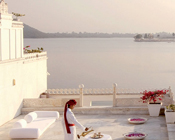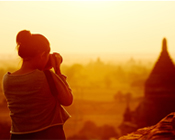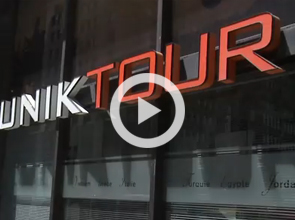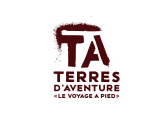Population & Culture
French culture is a reflection of its history and the variety of its regions: immense, prominent and deeply tied to the country's identity. Every visitor, according to his interests, his passions or his curiosity, will be completely delighted.
Arts
Tradition of art in France is as old and rich as the country itself. In most areas (sculpture, architecture, music, painting, among others), famous artists have distinguished themselves over the centuries and their works are exhibited in prestigious museums. The most famous (and largest in the world) is probably the Louvre in Paris, where a whole day is not enough for a complete visit. The departments of ancient art from Greece, Egypt and Mesopotamia contain thousands of treasures, while the same goes for the collections of paintings from the medieval times to the 18th century. The museum, which houses outstanding works as the Mona Lisa by Leonardo da Vinci, the Victory of Samothrace and the Venus de Milo, is a former palace of the kings of France, which construction began in the 12th century and was amended and extended until the 19th century by all its royal occupants. A bit further, the Musée d'Orsay houses the largest collection in the world of Impressionist paintings: Gauguin, Van Gogh, Manet and many others are abundantly represented. Art lovers will admire the modern Centre Pompidou, a contemporary achievement of the controversial architect Renzo Piano, whose galleries present works by Dufy, Duchamp, Leger, Picasso, Braque, Matisse, Chagall, Magritte, etc. On the banks of the Seine, not far from the majestic Belle Epoque buildings of the Grand and Petit Palais renowned for displaying prestigious exhibitions, the Palais de Tokyo is also devoted to vanguard creation and show the exceptionally vivid French contemporary art. This concentration of museums has helped to maintain Paris as a prestigious arts center on the international level. In the rest of the country, the Museums of Fine Arts in Lille and Lyon are also worth of great interest to art amateurs. Finally, the music and French film scenes are one of the most prolific and influential in the world, and go to a concert or to the movies figure prominently amongst the main common cultural activities of the population.
Gastronomy and wines
French culinary tradition dates back several centuries, and the variety of its cuisine is one of the main attractions that travelers come to taste, literally, in the country of the chefs. Each region owns emblematic recipes, and wherever your taste in cuisine goes, from the richest and juiciest to the most rustic, your taste buds will be filled with joy. Examples include traditional dishes that have been in plates for generations such as the beef and veal stews, the boeuf bourguignon, the cassoulet, the sauerkraut, the andouillette, not to mention the inevitable steak with frnch fies, on the top of the menu of every restaurant. However, the most symbolic dishes that can be found in upscale restaurants, branding the excellence of French cuisine will be foie gras, oysters and snails, to name a few.
A proverb says that France has as many cheeses as the year has days. In fact, there are even more, and more than 400 varieties are listed. Camembert, Bleu d'Auvergne, Alsace Munster, Reblochon, Roquefort or Brie de Meaux are the main ambassadors of a huge family with countless flavors, from the strongest to the sweetest.
Finally, a French meal is never done without a sweet note and again, an abundance of desserts will satisfy the pickiest palate: eclairs, religieuses, layer cakes, macaroons, strawberry pancakes, profiteroles, creme brulee ... are now exported throughout the world.
To come with all these delights, French wines suit well, and an impressive list of vineyards are to be found all over the country: white, red or pink wines from Bordeaux, Burgundy, Alsace, Charentes, not to mention the Cotes du Rhone and the most famous of all, champagne, are classified into thousands of denominations and can be enjoyed either over a casual meal or with a very strict professionalism. For this reason, wine has become an authentic symbol of French identity around the world.
Luxury and the arts of living
The French luxury has long ago been established as one of the pleasures of life and continues today to rule worldwide unquestionably. In many areas, references on top of the field are those from France. Acknowledged, copied, exported, they are another fundamental element of the culture of this country. Fashion, for example, with its famous designers, is an unavoidable phenomenon and Paris is often referred as its international capital. The prestigious Avenue Montaigne, in the heart of the wealthy district of Paris, lines an impressive amount of prestigious brands of haute couture or leather goods. Similarly, cosmetics, jewelry (like Place Vendome, another high end Paris sanctuary), fragrances, furniture, tableware, interior decoration, are all rich in an invaluable tradition inherited by centuries and have been continuously improved to keep high standards in prestige and excellence.
Architectural Heritage
History, the kings of France and the power of the Church have helped to build up an architectural heritage unique in its richness and variety in the Western world. The whole country displays lots of monuments representing all styles, from Romanesque to Gothic Revival. Ultimate symbol of royal power since the 17th century, the domain of Versailles, with its magnificent palace and its huge and supremely sophisticated gardens, invite to meet with the ghosts of the Sun King, Louis XIV and Marie Antoinette. Gilded salons, the Hall of Mirrors, immoderate views, everything was created back then to impose the French majesty the world. His cousins in the Paris region, Vaux-le-Vicomte and Fontainebleau, are also superb examples of classical architecture copied by other courts of Europe to distill a sense of boundless glory. In the mid-west of the country, along the banks of the Loire, stand many Renaissance castles (15th and 16th centuries), second homes and hunting lodges of the kings of the era: from the elegant arches of Chenonceau to the fairy tale silhouette of Usse, as well as the romantic island of Azay-le-Rideau and the overwhelming grandeur of Chambord, these landscapes nestled near the river loops are ideal for a quiet bike hiking. Southward, in the Aude, we will admire the imposing walls of Carcassonne, intact since the 13th century and the close ruins of Cathar castles. Lyon, the gastronomic capital of the country, is famous for its Italian-looking old town and the secret traboules. Travelling up to the east, near the German border, the timbered houses of old Strasbourg and Colmar are typical of this region and reminiscent of the medieval times, while Nancy, at Place Stanislas, presents an outstanding classic and Rococo (18th century) architecture ensemble with immaculate facades, gold leaf gates and delicate fountains.
The Church leaders have also printed their mark with structures like the great cathedrals in the north: Our Lady of Paris, Reims, where were sacred the kings of France, but also Amiens, Chartres and Soissons brought the Gothic at its most flamboyant level and were pioneer works with key architectural evolutions. At the other end of the country, the palace of the Popes in Avignon and its massive silhouette remains a privileged witness of the Catholic rebel parenthesis of the 14th century.
Finally, Paris has stored up countless treasures since it was proclaimed French capital 1500 years ago, and is filled with neighbourhoods full of charm: Montmartre, with the Place du Tertre and the Basilica of the Sacred Heart, is a favourite hangout tourists from around the world, while Saint-Germain des Prés has maintained the intellectual atmosphere of the 50s at the Cafe de Flore and the Deux Magots lounge bar, and the Bastille, now only adorned with a gigantic column, is one of the most vibrant area of the city. Near the Opera house, Haussmann architecture triumphs without sharing along the facades of the wide, elegant avenues, and leads to the vast and solemn Place de la Concorde, which opens onto the famous Champs Elysees. The gardens of Luxembourg and the Tuileries, lovers and students rendezvous spots, are among the most gorgeous parks in Europe, showing perfect examples of French style.

 1 (866) 722-0909
1 (866) 722-0909
 QUOTE REQUEST
QUOTE REQUEST 





































